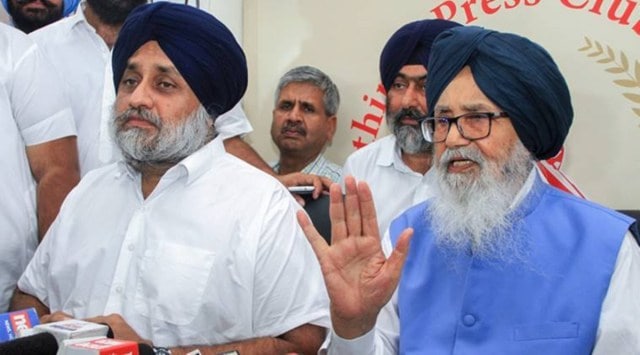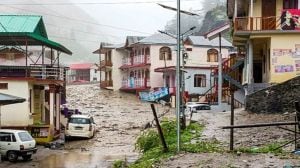Five things to know about Akali Dal as it turns 102 today
Shiromani Akali Dal (SAD) was formed as a volunteer group on December 14, 1920 to free gurdwaras from the control of mahants (priests) appointed by the British government, a month after the formation of Shiromani Gurdwara Parbandhak Committee (SGPC) on November 15.
 Parkash Singh Badal (right) and Sukhbir Singh Badal. (Source: PTI Photo)
Parkash Singh Badal (right) and Sukhbir Singh Badal. (Source: PTI Photo) As Shiromani Akali Dal turns 102 on November 14, here are five things about its foundation:
1. Shiromani Akali Dal (SAD) was formed as a volunteer group on December 14, 1920 to free gurdwaras from the control of mahants (priests) appointed by the British government, a month after the formation of Shiromani Gurdwara Parbandhak Committee (SGPC) on November 15. Dalmegh Singh, former secretary of SGPC, says the movement started due to several reasons, an immediate trigger being “eve-teasing” of the daughter of a Deputy Commissioner while paying obeisance at Nankana Sahib. “There was outrage at this incident, and it was felt that gurdwaras should be freed from mahants.”
The Akali Dal launched a peaceful struggle that lasted four years and resulted in the death of 4,000 protesters, who were attacked both by mahants and by the British administration. The morcha finally led to the enactment of the Sikh Gurdwaras Act 1925, which brought gurdwaras under the control of the SGPC. It also pitched the party against the colonial government, paving the way for its alliance with Congress party. The Akali Dal aligned with the Congress during the pre-Independence period, starting in the 1930s and continuing in the 1940s.
2. The Akali Dal started calling for the creation of a Punjabi Suba soon after the government of India appointed the States Reorganisation Commission in December 1953. The demand, in part, stemmed from the concentration of Sikhs, who formed 35% of the population in the post-Partition Punjab.
In 1956, the Akali Dal, led by Sant Fateh Singh, launched a movement for Punjabi Suba with protesters courting arrest in thousands.
Chief Minister Bhim Sen Sachar’s decision to make both Hindi and Punjabi the official languages of the state in 1957 gave a further fillip to the morcha. The States Reorganisation Commission’s decision to reject the demand for a Suba based on the Punjabi language, on the plea that it wasn’t distinct enough from Hindi to count as a separate language, came as the last straw. The Akali Dal called it discriminatory, pointing out how each of the 14 official languages had been given a state.
The two top Akali leaders, Sant Fateh Singh and Master Tara Singh, sat on long fasts, the former for 22 days towards the end of 1960, and the latter for 48 days from August 15, 1961, to drum up support for their demand, but Prime Minister Jawaharlal Nehru remained unmoved. In all, around 57,000 Akalis were jailed during this agitation.
The movement for a Punjabi-speaking state also had supporters among other religions, most notably Seth Ram Nath, a Congress minister who broke ranks to support it.
Akalis suspended the Punjabi Suba movement during the 1962 and 1965 wars, and instead took part in the war efforts with generous supply of both men and material. Fateh Singh made a personal contribution of Rs 50,000 and twice the weight of Nehru was given in gold to the government.
Finally, the Gulzari Lal Nanda government at the Centre relented and Lok Sabha passed the Punjab Reorganisation Act 1966, and Punjab in its present form became a reality on November 1, 1966.
3. A year after the landslide victory of Congress in the 1972 Assembly elections, the Akali Dal, which had fallen into the hands of orthodox leaders after the death of Sant Fateh Singh who had given it a secular ideology, passed the. Anandpur Sahib resolution, seeking an independent political status for the community.
In 1978, the party revised the resolution and shifted the focus from the panthic agenda (Khalse ka Bol Bala) to autonomy for the state. SGPC president Gurcharan Singh Tohra, who moved the resolution, underlined that devolution of power was important for economic growth, and strong states did not translate into a weak Centre. The resolution also sought transfer of Chandigarh to Punjab and readjustment of boundaries to include certain Punjabi-speaking territories of neighbouring states
The Akalis began negotiations with the Congress government at the Centre on the resolution. When talks failed, the party headed by Sant Harcharan Singh Longowal launched Dharam Yudh Morcha, on August 4, 1982, in alliance with Sant Jarnail Singh Bhindranwale, head of the Sikh seminary Damdami Taksal whose Dharma Prachar movement and radical rhetoric had won him a big following in the hinterland.
4. When militancy supported by Pakistan swept Punjab with hardliners calling for a separate sovereign Sikh state, the
Akali Dal was splintered into many factions as moderates were pushed to the fringes.
The stalemate between the Centre and Akali Dal led to Operation Bluestar in June 1984, which was followed by the assassination of Prime Minister Indira Gandhi by her Sikh bodyguards, and the anti-Sikh pogrom in October.
A year later, moderate Akali leaders led by Sant Harchand Singh Longowal resumed talks with the Rajiv Gandhi-led central government which resulted in the Rajiv Gandhi-Longowal Accord on July 24 1985. The Akali government led by S S Barnala that followed didn’t last very long, and with radical elements taking over the state, it was put under President’s rule for five years from 1987.
But by the mid-90s, Akali Dal led by Prakash Singh Badal, managed to pull in most moderate factions into its fold, and hardliners like Akali Dal (Amritsar ) were gradually marginalised.
5. It was in 1996 that Akali Dal announced its ideological transformation into a party of all Punjabis, regardless of their religion or geography in its Moga declaration. In his address at Moga, party president Prakash Singh Badal declared that Akali Dal stood for ‘Punjab, Punjabi and Punjabiyat’. The Moga declaration said, “The spirit of Punjabiyat would be strengthened so that these matters get projected as common problems of the entire Punjabis rather than a section thereof.’’
The party has now admitted a large number of Hindus, and in the 2012 Assembly elections, 10 of its 11 Hindu candidates won.
The Akali Dal was the first to support the BJP-led NDA at the Centre in 1998. Ever since 1997, Akali Dal fought all the elections in the state in alliance with the BJP, winning three Assembly elections.
Their relations soured in 2020 when Akali Dal objected to the three contentious farm laws following a massive uprising of farmers in Punjab. The party, which had initially supported these laws, quit the central government and severed its ties with BJP as soon as these laws were passed in September.
Once known for its strong cadre and inner-party democracy, the Akali Dal now faces the charge of being a fiefdom of the Badals. It was in 2004 that party patron Parkash Singh Badal anointed his son Sukhbir Badal the party president, in the process becoming the first sitting president to do so. Although Sukhbir has been widely credited with strengthening the secular credentials of the party, this has come alongside misgovernance coupled with concentration of power in the hands of the family. Dogged by instances of sacrilege and widespread drug trafficking during its 10-year tenure, the party’s tally went down to 15 in the 2017 Assembly polls. In the 2022 assembly polls, the party could win only three seats.












